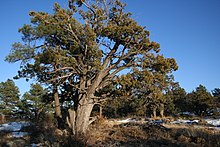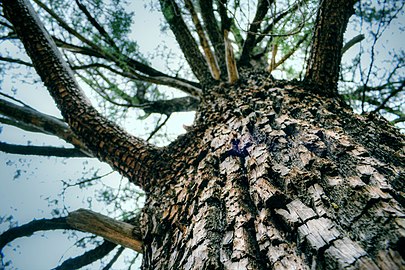|
Juniperus deppeana
Juniperus deppeana (alligator juniper or checkerbark juniper) is a small to medium-sized tree reaching 10–15 metres (33–49 feet) in height. It is native to central and northern Mexico and the southwestern United States. DescriptionThe tree reaches 10–15 metres (33–49 feet), rarely 25 m (82 ft), in height. The bark is usually very distinctive, unlike other junipers, hard, dark gray-brown, cracked into small square plates superficially resembling alligator skin; it is however sometimes like other junipers, with stringy vertical fissuring. The shoots are 1–1.5 millimetres (1⁄32–1⁄16 inch) in diameter. On juvenile specimens, the leaves are needle-like and 5–10 mm (3⁄16–3⁄8 in) long. The leaves are arranged in opposite decussate pairs or whorls of three; in adulthood they are scale-like, 1–2.5 mm (1⁄16–1⁄8 in) long (up to 5 mm) and 1–1.5 mm broad. The cones are berrylike, 7–15 mm (1⁄4–9⁄16 in) wide, green when young and maturing to orange-brown with a whitish waxy bloom,. These contain 2–6 seeds, which mature in about 18 months. The male cones are 4–6 mm (3⁄16–1⁄4 in) long, and shed their pollen in spring. The species is largely dioecious, producing cones of only one sex on each tree, but occasional trees are monoecious.
TaxonomyThere are five varieties, not accepted as distinct by all authorities:
EtymologyNative American[clarification needed] names include táscate and tláscal. Distribution and habitat It is native to central and northern Mexico (from Oaxaca northward) and the southwestern United States (Arizona, New Mexico, western Texas). It grows at moderate altitudes of 750–2,700 m (2,460–8,860 ft) on dry soils. EcologyThe berrylike cones are eaten by birds and mammals.[2][3] UsesBerries from alligator juniper growing in the Davis Mountains of West Texas are used to flavor gin, including one produced by WildGins Co. in Austin, Texas.[4] References
External linksWikimedia Commons has media related to Juniperus deppeana.
|
||||||||||||||||||||||||||||||||||||||||








